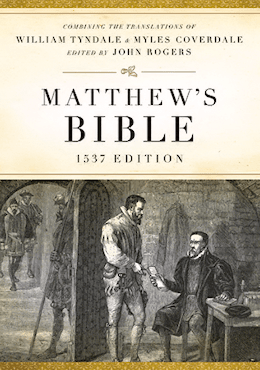Textus Receptus Bibles
Matthew's Bible 1537
| 14:1 | And these are the countreyes whiche the children enhered in the land of Canaan, vnto which Eleazar the prieste, and Iosua the sonne of Nun, and the auncient heades of the trybes of the chyldren of Israel, |
| 14:2 | gaue them their enheritaunce by lotte, as the Lorde commaunded by the hande of Moses, to geue vnto the nyne trybes, and vnto the halfe trybe of Manasses. |
| 14:3 | For Moses had geuen enheritaunce vnto two tribes and an halfe on the other syde Iordan. But vnto the Leuites he gaue none enheritaunce among them. |
| 14:4 | For the chyldren of Ioseph were two trybes, Manasses and Ephraim. And therfore they gaue no parte vnto the Leuites in the lande, saue cyties to dwelle in, and the suburbes of the same, for their beastes & cattel |
| 14:5 | as the Lorde commaunded Moses, euen so the chyldren of Israel dyd when they deuided the lande. |
| 14:6 | And the chyldren of Iuda came vnto Iosua in Galgall. And Caleb the sonne of Iephune the Kenesyte sayd vnto him, thou wotest what the Lord said vnto Moses the man of God, aboute me and the in Cades Barne. |
| 14:7 | Fourty yere olde was I, when Moses the seruaunte of the Lorde sente me from Cades barne to spye oute the lande. And I brought him worde again, euen as I thought in myne herte. |
| 14:8 | Neuerthelesse my brethren that wente vp wysh me discouraged the hertes of the people. But I folowed the Lord my God euen vnto the ende. |
| 14:9 | And Moses sware the same ceason saying the lande wheron thy fete haue trooden, shalbe thyne enheritaunce, & thy children for euer because thou hast folowed the Lord my God continuallye. |
| 14:10 | And now behold, the Lord hath kepte me lusty (as he sayd) this fourtye and fyue yeares, euen sence the Lorde spake vnto vnto Moses, whyle the chyldren of Israell wanderyd in the wyldernesse. And now se I am thys daye foure skore and fyue yeres, |
| 14:11 | and yet am as stronge at thys tyme, as I was when Moses sent me: loke how strong I was then, so strong I am now, to warre and to do al maner of thynges. |
| 14:12 | Now therfore geue me thys mountayne, whyche the Lorde at that tyme promysed, for thou herdest at that tyme, how the Enakims were there, and how the cytyes were greate & walled. I trust the Lord wylbe wyth me, and I shal dryue them out as the Lorde sayd. |
| 14:13 | And Iosua blessed Caleb the sonne of Iephune & gaue him Hebron to enherete. |
| 14:14 | And Hebron became the enheritaunce of Caleb the sonne of Iephune the kenesite, vnto this daye: because he folowed the Lorde God of Israell perpetually. |
| 14:15 | And the name of Hebron, was called in the olde tyme, Kariatharbe, which was a huge man among the Enakims. And the lande ceased from warre. |

Matthew's Bible 1537
The Matthew Bible, also known as Matthew's Version, was first published in 1537 by John Rogers, under the pseudonym "Thomas Matthew". It combined the New Testament of William Tyndale, and as much of the Old Testament as he had been able to translate before being captured and put to death, with the translations of Myles Coverdale as to the balance of the Old Testament and the Apocrypha, except the Apocryphal Prayer of Manasses. It is thus a vital link in the main sequence of English Bible translations.